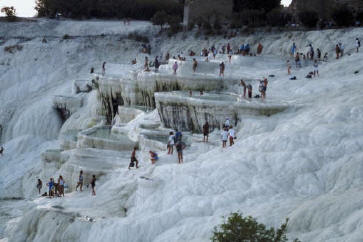|

Nitrogen gas molecule
|
|

Nitric acid |
The
diatomic nitrogen gas molecule (N2) is a colorless,
odorless, and tasteless gas, making up 78.1% by volume of atmospheric
gas that we breathe. Nitrogen is present in all living organisms
including protein. The ion (N-) combines with oxygen
to form different compounds in the atmosphere, especially nitrogen
dioxide (NO2) which is a reddish-brown gas with a
characteristic sharp odor. It is one of the poisonous gases found in
smog as an air pollutant harmful to humans. Nitric acid (HNO3)
is highly
corrosive and toxic causing severe burns.
Carbonate ion (CO3-2 )
is a polyatomic ion that bonds with calcium to form calcium
carbonate (CaCO3). The carbonate ion binds with many
other cations and the family is called “carbonate salts.” There are
also many minerals that belong to the carbonate family. They can be
readily identified because if you put an acid on the mineral, it will
fizz. Calcium carbonate is given the mineral name, calcite and
is very common mineral.
|

A calcium carbonate area in Turkey that looks like snow, but it is
not. |
|